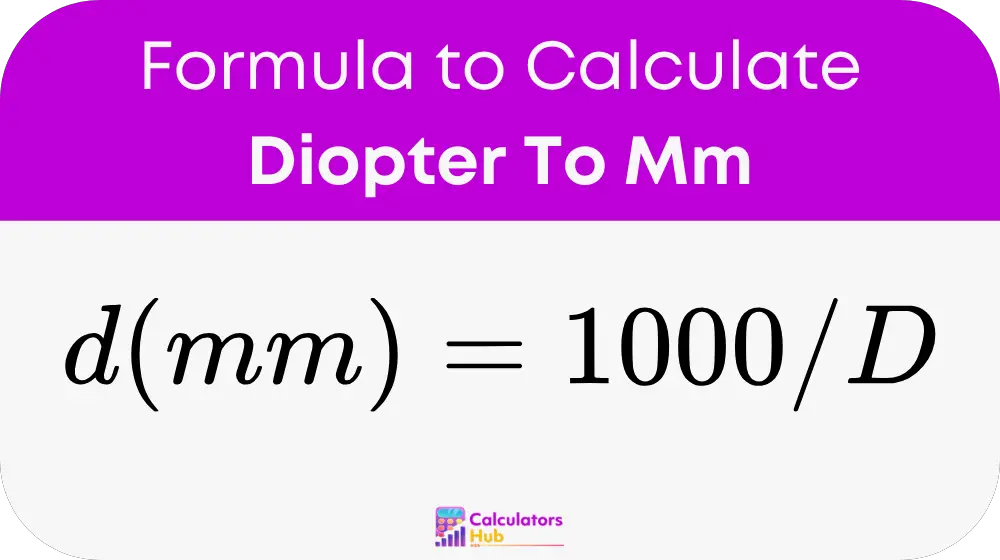The Diopter To Mm Calculator is a specialized optical calculation tool that converts diopter values (a measurement of optical power) into millimeters (a measurement of focal length or distance). This conversion is crucial because it translates the abstract concept of optical power into a concrete physical measurement.
Eye care professionals use this calculator to translate prescription values into practical lens specifications. Photographers rely on it to select appropriate close-up lenses and understand depth of field. Optical engineers need it to design lenses with specific focal properties. Patients benefit from understanding their vision prescriptions in more tangible terms. Students learning about optics can connect theoretical values to physical measurements.
Formula of Diopter To Mm Calculator
The relationship between diopters and millimeters follows a simple but powerful mathematical formula. Here's how the Diopter to Mm Calculator works:
Diopter to Millimeter Formula:

Where:
d(mm) = distance in millimeters
D = diopter value
This formula expresses the inverse relationship between diopter values and focal distances. The number 1000 in the formula represents the conversion factor from meters to millimeters, as the standard diopter definition is based on meters (1 diopter = 1/meter).
The formula works for both positive and negative diopter values:
- Positive diopters (like those in reading glasses) yield positive focal lengths
- Negative diopters (like those for nearsightedness) yield negative focal lengths
Additionally, the formula confirms that as diopter values increase, focal lengths decrease. This makes sense because stronger lenses (higher diopter values) focus at shorter distances.
Diopter to Millimeter Conversion Table
This reference table provides common diopter values and their corresponding focal lengths in millimeters. Use it for quick lookups without calculating each time:
| Diopter Value | Focal Length (mm) | Common Application |
|---|---|---|
| +0.25 | 4000 | Very mild reading glasses |
| +0.50 | 2000 | Mild reading glasses |
| +0.75 | 1333 | Reading glasses |
| +1.00 | 1000 | Reading glasses |
| +1.25 | 800 | Reading glasses |
| +1.50 | 667 | Reading glasses |
| +1.75 | 571 | Reading glasses |
| +2.00 | 500 | Standard reading glasses |
| +2.50 | 400 | Stronger reading glasses |
| +3.00 | 333 | Strong reading glasses |
| +4.00 | 250 | Very strong reading glasses |
| +5.00 | 200 | Magnifying glasses |
| +8.00 | 125 | Strong magnifiers |
| +10.00 | 100 | High power magnifiers |
| -0.50 | -2000 | Mild nearsightedness correction |
| -1.00 | -1000 | Mild nearsightedness correction |
| -2.00 | -500 | Moderate nearsightedness correction |
| -3.00 | -333 | Moderate nearsightedness correction |
| -4.00 | -250 | Strong nearsightedness correction |
| -5.00 | -200 | Strong nearsightedness correction |
| -6.00 | -167 | Very strong nearsightedness correction |
Note: This table covers both positive diopters (converging lenses) and negative diopters (diverging lenses) commonly found in vision prescriptions.
Example of Diopter To Mm Calculator
Let's explore a practical example to understand how the Diopter to Mm Calculator works in a real-life situation:
Reading Glasses Example
Suppose you have reading glasses with a power of +2.50 diopters. What is the focal length in millimeters?
Using the formula: d(mm) = 1000 / D
d(mm) = 1000 / 2.50
d(mm) = 400 millimeters
This means your reading glasses focus best at 400mm (or 40cm) from your eyes, which is a typical reading distance. Understanding this relationship helps you know the optimal distance to hold reading materials for the clearest vision with these particular glasses.
Most Common FAQs
Positive diopters represent converging lenses (for farsightedness/presbyopia), while negative diopters represent diverging lenses (for nearsightedness). Positive values give positive focal lengths; negative values give negative focal lengths.
Close-up filters rated in diopters can be converted to determine exact focusing distances. A +2 diopter filter has a 500mm focal length, meaning subjects at this distance will be in sharp focus. Higher diopter values allow closer macro photography.
Yes, this calculator translates prescriptions into meaningful distances. For reading glasses, it shows optimal reading distance. For nearsightedness correction, the negative value indicates lens type rather than usable distance. Remember that prescriptions may include additional measurements for astigmatism.